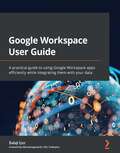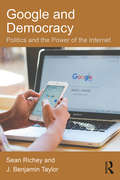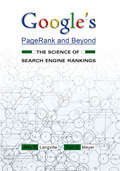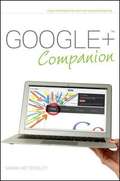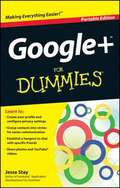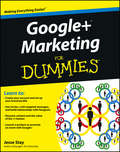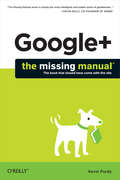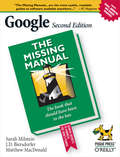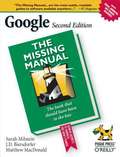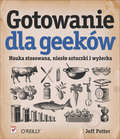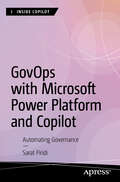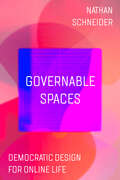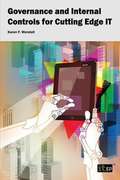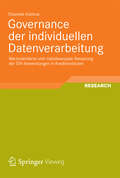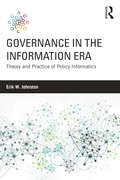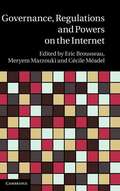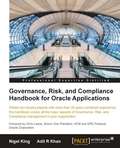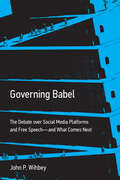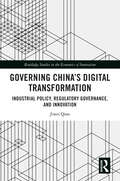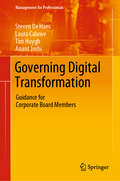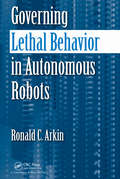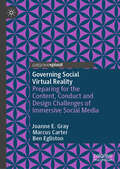- Table View
- List View
Google Workspace User Guide: A practical guide to using Google Workspace apps efficiently while integrating them with your data
by Balaji Iyer Abhi JeevaganambiExplore the suite of apps that enhance productivity and promote efficient collaboration in your businessKey FeaturesSet up your own project in Google Workspace and improve your ability to interact with different servicesUnderstand how a combination of options can help businesses audit their data to be highly secureDeploy Google Workspace, configure users, and migrate data using Google WorkspaceBook DescriptionGoogle Workspace has evolved from individual Google services to a suite of apps that improve productivity and promote efficient collaboration in an enterprise organization.This book takes you through the evolution of Google Workspace, features included in each Workspace edition, and various core services, such as Cloud Identity, Gmail, and Calendar. You'll explore the functionality of each configuration, which will help you make informed decisions for your organization. Later chapters will show you how to implement security configurations that are available at different layers of Workspace and also how Workspace meets essential enterprise compliance needs. You'll gain a high-level overview of the core services available in Google Workspace, including Google Apps Script, AppSheet, and Google Cloud Platform. Finally, you'll explore the different tools Google offers when you're adopting Google Cloud and migrating your data from legacy mail servers or on-premises applications over to cloud servers.By the end of this Google Workspace book, you'll be able to successfully deploy Google Workspace, configure users, and migrate data, thereby helping with cloud adoption.What you will learnManage and configure users in your organization's Workspace accountProtect email messages from phishing attacksExplore how to restrict or allow certain Marketplace apps for your usersManage all endpoints connecting to Google WorkspaceUnderstand the differences between Marketplace apps and add-ons that access Drive dataManage devices to keep your organization's data secureMigrate to Google Workspace from existing enterprise collaboration toolsWho this book is forThis book is for admins as well as home users, business users, and power users looking to improve their efficiency while using Google Workspace. Basic knowledge of using Google Workspace services is assumed.
Google and Democracy: Politics and the Power of the Internet
by J. Benjamin Taylor Sean RicheyFor the first time in human history, access to information on almost any topic is accessible through the Internet. A powerful extraction system is needed to disseminate this knowledge, which for most users is Google. Google Search is an extremely powerful and important component to American political life in the twenty-first century, yet its influence is poorly researched or understood. Sean Richey and J. Benjamin Taylor explore for the first time the influence of Google on American politics, specifically on direct democracy. Using original experiments and nationally representative cross-sectional data, Richey and Taylor show how Google Search returns quality information, that users click on quality information, and gain political knowledge and other contingent benefits. Additionally, they correlate Google usage with real-world voting behavior on direct democracy. Building a theory of Google Search use for ballot measures, Google and Democracy is an original addition to the literature on the direct democracy, Internet politics, and information technology. An indispensable read to all those wishing to gain new insights on how the Internet has the power to be a normatively valuable resource for citizens.
Google for Lawyers: Essential Search Tips and Productivity Tools
by Carole A. Levitt Mark E. RoschLevitt, an attorney and former law librarian and Rosch, an attorney who runs a website for lawyers doing Internet research, detail how lawyers can use free and low-cost tools available through Google to compete with large firms and their large research and technology budgets. They explain how to use Google Scholar's case law database, Gmail, advertising, and the Google applications: Docs, News, Groups, Images, Blogs, Finance, Books, Chrome, Knol, Maps, Desktop Search, Calendar, Voice, Wave, Analytics, Translate, and other programs for basic and advanced research and office use. They include tips for searching case law and articles; locating information about the opposition, expert witnesses and jurors, and clients; and finding missing witnesses and heirs. Screen shots are included. Annotation ©2010 Book News, Inc. , Portland, OR (booknews. com)
Google's PageRank and Beyond: The Science of Search Engine Rankings
by Amy N. Langville Carl D. MeyerWhy doesn't your home page appear on the first page of search results, even when you query your own name? How do other web pages always appear at the top? What creates these powerful rankings? And how? The first book ever about the science of web page rankings, Google's PageRank and Beyond supplies the answers to these and other questions and more. The book serves two very different audiences: the curious science reader and the technical computational reader. The chapters build in mathematical sophistication, so that the first five are accessible to the general academic reader. While other chapters are much more mathematical in nature, each one contains something for both audiences. For example, the authors include entertaining asides such as how search engines make money and how the Great Firewall of China influences research. The book includes an extensive background chapter designed to help readers learn more about the mathematics of search engines, and it contains several MATLAB codes and links to sample web data sets. The philosophy throughout is to encourage readers to experiment with the ideas and algorithms in the text. Any business seriously interested in improving its rankings in the major search engines can benefit from the clear examples, sample code, and list of resources provided. Many illustrative examples and entertaining asides MATLAB code Accessible and informal style Complete and self-contained section for mathematics review
Google+ Companion
by Mark HattersleyGet the inside scoop on the newest social networking site: Google+If you think you've seen it all when it comes to social networking sites, you haven't seen Google+ yet! Built from the ground up to be useful to both desktop and mobile users, Google+ offers the same great features as other popular social network sites?yet, Google+ goes one step further by integrating popular Google technologies and introducing exciting new and unique features such as "Circles," "Hang," and "Sparks." Using clear, step-by-step instructions, Google+ Companion helps you master this amazing new social networking technology. Highlights the new and innovative features of Google+ with the use of clear, easy-to-understand descriptions Introduces you to "Circles," a brilliant feature that allows users to decide what updates and personal information each group of friends see Shares helpful details to explain "Hang": the new group video feature Walks you through "Sparks," which integrates Google search into the social network Addresses how Google+ will be supported on desktop computers as well as Android and iOS devices Step into the newest world of social networking sites with Google+ Companion!
Google+ For Dummies, Portable Edition
by Jesse StayA new social network! Here's your user's guide to Google+ Google+ is Google's new social network and from day one it has had the social media world abuzz with excitement. Early fans claim it's easier to use than Facebook and Twitter and has a wealth of creative new features. If you want to learn how to navigate this new social neighborhood, take along Google+ For Dummies as your guide. Early Google+ adopter and social media consultant Jesse Stay shows you how to get started, create a profile, set up privacy settings, chat, post, control who sees what, and much more. Explains how to join Google+, protect your information, and make the most of this new social network Explores cool new features, such as Circles, which allows you to drag and drop friends into different circles Covers creating a profile, finding friends, adding people to Circles, chatting with others in Hangouts, importing photos, controlling who sees what, and more Conveys helpful information in the clear, friendly, easy-to-follow language that has defined the Dummies series for two decades Confidently enter the exciting new Google+ social neighborhood with Google+ For Dummies.
Google+ Marketing For Dummies
by Jesse StayOrganize customers, craft targeted messages, or host Hangouts with Google?s social networkGoogle+ is Google's social network that has the social media world abuzz with excitement. With Google tools like YouTube, Picasa, Blogger, and Picnik being integrated with Google+, marketers will find Google+ is the best way to reach the long-time users of Google?s other tools. Google+ expert Jesse Stay shows you how to create and maximize your Google+ presence to connect with your customers.Explains how to sign up for your account and set up your brand profileShows you how to use Circles, craft targeted messages for the Stream, and add multimedia features to your postsHelps you discover content and the value of the +1 buttonShows you how to be mindful of SEO, so that your Google+ brand page can be foundAddresses using Google+ to launch a product or promote an eventConfidently enter the exciting new Google+ social neighborhood with Google+ Marketing For Dummies.
Google+: The Missing Manual
by Kevin PurdyIf you want to gain more control over your social networking activities with Google+, this jargon-free guide helps you quickly master the ins and outs of the site. Learn how to organize your contacts, hold video chats with as many as ten people, and determine exactly who may learn what about you. With this book, you'll navigate Google+ with ease. The important stuff you need to know Massage your profile. Control what the public, specific groups, or certain individuals can see about you. Move in the right circles. Assign folks to different groups and share the right stuff with the right people. Jump into streams. Get all the updates, pictures, and links from people you know. Host hangouts. Organize and attend group video chats. View and share photos. Make them available to whomever you like--whether or not they're Google+ members. Get notifications. Monitor what others do (and share about you) on Google+. Go mobile. Use Google+ on your Android, iPhone, or mobile web browser.
Google+: The Missing Manual (Oreilly And Associate Ser.)
by Kevin PurdyIf you want to gain more control over your social networking activities with Google+, this jargon-free guide helps you quickly master the ins and outs of the site. Learn how to organize your contacts, hold video chats with as many as ten people, and determine exactly who may learn what about you. With this book, you’ll navigate Google+ with ease.The important stuff you need to knowMassage your profile. Control what the public, specific groups, or certain individuals can see about you.Move in the right circles. Assign folks to different groups and share the right stuff with the right people.Jump into streams. Get all the updates, pictures, and links from people you know.Host hangouts. Organize and attend group video chats.View and share photos. Make them available to whomever you like—whether or not they’re Google+ members.Get notifications. Monitor what others do (and share about you) on Google+.Go mobile. Use Google+ on your Android, iPhone, or mobile web browser.
Google: The Missing Manual (Google: The Missing Manual)
by Rael Dornfest J. D. Biersdorfer Sarah Milstein Matthew MacDonaldGoogle.com is one of the most popular sites on the Internet and is used around the world by millions of people every day. Sure, you know how to "Google it" when you're searching for something--anything!--on the Web. It's plenty fast and easy to use. But did you know how much more you could achieve with the world's best search engine by clicking beyond the "Google Search" button?While you can interface with Google in 97 languages and glean results in 35, you can't find any kind of instruction manual from Google. Lucky for you, our fully updated and greatly expanded second edition to the bestselling Google: The Missing Manual covers everything you could possibly want to know about Google, including the newest and coolest--and often most underused (what is Froogle, anyway?)--features. There's even a full chapter devoted to Gmail, Google's free email service that includes a whopping 2.5 GB of space).This wise and witty guide delivers the complete scoop on Google, from how it works to how you can search far more effectively and efficiently (no more scrolling through 168 pages of seemingly irrelevant results); take best advantage of Google's lesser-known features, such as Google Print, Google Desktop, and Google Suggest; get your website listed on Google; track your visitors with Google Analytics; make money with AdWords and AdSense; and much more.Whether you're new to Google or already a many-times-a-day user, you're sure to find tutorials, tips, tricks, and tools that take you well beyond simple search to Google gurudom.
Google: The Missing Manual, 2nd Edition
by Matthew Macdonald Rael Dornfest J. D. Biersdorfer Sarah MilsteinGoogle.com is one of the most popular sites on the Internet and is used around the world by millions of people every day. Sure, you know how to "Google it" when you're searching for something--anything!--on the Web. It's plenty fast and easy to use. But did you know how much more you could achieve with the world's best search engine by clicking beyond the "Google Search" button? While you can interface with Google in 97 languages and glean results in 35, you can't find any kind of instruction manual from Google. Lucky for you, our fully updated and greatly expanded second edition to the bestselling Google: The Missing Manual covers everything you could possibly want to know about Google, including the newest and coolest--and often most underused (what is Froogle, anyway?)--features. There's even a full chapter devoted to Gmail, Google's free email service that includes a whopping 2.5 GB of space). This wise and witty guide delivers the complete scoop on Google, from how it works to how you can search far more effectively and efficiently (no more scrolling through 168 pages of seemingly irrelevant results); take best advantage of Google's lesser-known features, such as Google Print, Google Desktop, and Google Suggest; get your website listed on Google; track your visitors with Google Analytics; make money with AdWords and AdSense; and much more. Whether you're new to Google or already a many-times-a-day user, you're sure to find tutorials, tips, tricks, and tools that take you well beyond simple search to Google gurudom.
Google®: How Larry Page & Sergey Brin Changed the Way We Search the Web
by Aurelia JacksonGoogle is one of the most successful companies of the Internet age. For many people, looking up information with Google's search engine is the best way to find just what they want to know. Millions of people write and read e-mails using Google's Gmail. You can listen to music on Google Play or share a document with a friend using Google Drive. Today, Google also owns YouTube, the number-one video site on the Internet. You may use Google websites every day, but do you know the story of the men behind Google--Larry Page and Sergey Brin? Find out how Larry and Sergey started the company and how they got their first inspiration. Learn how Google grew to become the amazing success we all know today.
Gotowanie dla Geeków. Nauka stosowana, niez?e sztuczki i wy?erka
by Jeff PotterNie samym kodem informatyk ?yje!Cho? trudno to sobie wyobrazi?, w ?yciu ka?dego programisty, administratora, webmastera czy hakera przychodzi w ko?cu taka chwila, kiedy musi wyj?? zza ukochanego monitora… i najzwyczajniej w ?wiecie co? zje??! W ko?cu informatyk te? cz?owiek i nie tylko g?ód wiedzy zaglšda mu w oczy! Niestety nikt nie wymy?li? jeszcze sposobu na to, by ?cišgnš? z sieci aplikacj? z technikami kuchennymi i za?adowa? jš bezpo?rednio do komórek pami?ci. Je?li wi?c b?šd w programie w?šcza w Tobie automatyczny mechanizm rozwišzywania pasjonujšcej zagadki, a w kuchni ko?czy si? powa?nš awariš skutkujšcš zamówieniem pizzy - pora spojrze? na gotowanie jak na nowy, pasjonujšcy algorytm. Wbrew pozorom tutaj tak?e cišg jasno zdefiniowanych czynno?ci daje oczekiwany wynik, a nauka gotowania podobnie jak zg??bianie linijek kodu nierozerwalnie ?šczy si? z dociekliwo?ciš, zadawaniem pyta? i znajdowaniem ?róde? informacji. Chyba co? o tym wiesz, prawda? Trzymasz w r?kach co? wi?cej ni? zwyk?š ksiš?k? kucharskš. Oto pierwsza publikacja dla informatyków, która zamiast zagoni? Ci? do klawiatury, wyp?dzi Ci? zza niej i zainspiruje do smakowitych kulinarnych eksperymentów! Otrzymasz przy tym solidnš porcj? sycšcej umys? i ?o?šdek wiedzy, m.in. na temat niezb?dnych w kuchni narz?dzi, sk?adników, czasu i temperatury gotowania poszczególnych produktów czy fizjologii smaku i zapachu. Autor i pasjonat sztuki kulinarnej, Jeff Potter, udzieli Ci mnóstwa praktycznych wskazówek i zasypie ?wietnymi przepisami o ró?nym stopniu trudno?ci — od tych s?odkich i dziecinnie prostych po niezwykle wyrafinowane. Na kartach ksiš?ki znajdziesz tak?e mnóstwo podsycajšcych Twojš kreatywno?? wywiadów oraz rozmów z naukowcami, technologami ?ywienia, mistrzami kulinarnymi i autorami kuchennych blogów. Wszystko po to, aby szybko i przyjemnie przybli?y? Ci? do realizacji ambitnego zadania, przygotowania smacznego i zdrowego posi?ku!http://blogi.helion.pl/lyceum/gotowanie-dla-geekow">Poznaj przepisy Jeffa Pottera na blogu o gotowaniu! »A oto przedsmak tego, co znajdziesz na kolejnych kartach ksiš?ki:Przygotujesz swojš kuchni? do wielkich wyzwa? i dokonasz kalibracji narz?dzi, którymi dysponujesz.Dowiesz si?, dlaczego niektóre produkty piecze si? w temperaturze 175°C, a inne w 190°C, a tak?e jak szybko przygotowa? pizz?, je?li podkr?cisz piekarnik do 540°C.Poznasz najwa?niejsze reakcje, z jakimi b?dziesz mie? do czynienia podczas gotowania — denaturacj? bia?ek, reakcj? Maillarda, karmelizacj?. I dowiesz si?, jak wp?ywajš one na przyrzšdzane przez Ciebie dania.Poeksperymentujesz i zabawisz si? z potrawami, wykorzystujšc hydrokoloidy i technik? sous vide.Dowiesz si?, co majš do powiedzenia naukowcy, technolodzy ?ywienia, eksperci od no?y, mistrzowie kulinarni, autorzy i inne osoby tworzšce przebogaty ?wiat sztuki kulinarnej, zamieszkiwany przez takich samych zapale?ców, jak pasjonaci komputerów!Apetyt ro?nie w miar? czytania!Ksiš?k? Gotowanie dla geeków http://kuchniaplus.pl/kuchnia_wideo_886_tytul-na-widelcu-3-odc-4.html">poleca Kuchnia +!
GovOps with Microsoft Power Platform and Copilot: Automating Governance (Inside Copilot)
by Sarat PiridiIn an era of tightening budgets and rising citizen expectations, government agencies must modernize or risk obsolescence. This book provides a comprehensive, hands‑on roadmap for public sector leaders, architects, and developers to harness Microsoft Power Platform’s low‑code and AI capabilities with Power Apps, Power Automate, Power BI, Power Pages, AI Builder, Copilot, and Dataverse. This book lays out the case for low‑code modernization, demonstrates how to assess organizational readiness, and introduces governance and CoE best practices. Readers will walk away with repeatable frameworks, proven templates, and scripts to accelerate digital transformation in any government setting to foster transparency, efficiency, and citizen‑first service delivery. What You Will Learn Core Platform Deep Dive: Unpacks each Power Platform component with architecture patterns, step‑by‑step tutorials, and design guidelines using official Microsoft icons. Sector‑Specific Use Cases: Shares rich, real‑world examples from licensing and permitting to emergency response coordination, complete with workflows, code samples, and architecture diagrams. Advanced AI & Copilot Integrations: Shows how to train custom AI models, implement Copilot–powered natural‑language generation, and embed responsible AI with human‑in‑the‑loop designs. Operational Excellence, ALM & the Road Ahead: Covers CI/CD pipelines, environment management, security/DLP policy enforcement, accessibility, and next‑gen Copilot trends. Who This Book is For This book is for IT leaders, solution architects, citizen developers, line‑of‑business analysts, and public sector project managers looking to modernize government services. Readers should have some familiarity with Microsoft 365 or basic low-code.
Governable Spaces: Democratic Design for Online Life
by Nathan SchneiderA free ebook version of this title is available through Luminos, University of California Press's Open Access publishing program. Visit www.luminosoa.org to learn more. When was the last time you participated in an election for an online group chat or sat on a jury for a dispute about a controversial post? Platforms nudge users to tolerate nearly all-powerful admins, moderators, and "benevolent dictators for life." In Governable Spaces, Nathan Schneider argues that the internet has been plagued by a phenomenon he calls "implicit feudalism": a bias, both cultural and technical, for building communities as fiefdoms. The consequences of this arrangement matter far beyond online spaces themselves, as feudal defaults train us to give up on our communities' democratic potential, inclining us to be more tolerant of autocratic tech CEOs and authoritarian tendencies among politicians. But online spaces could be sites of a creative, radical, and democratic renaissance. Using media archaeology, political theory, and participant observation, Schneider shows how the internet can learn from governance legacies of the past to become a more democratic medium, responsive and inventive unlike anything that has come before.
Governance and Internal Controls for Cutting Edge IT
by Karen F. WorstellTo remain competitive we rely on being early adopters of new technologies - but there are inherent risks. As we implement these technologies, how do we manage the risks without hindering the progress of the business? In Governance and Internal Controls for Cutting Edge IT, Karen Worstell explains strategies and techniques to guide IT managers as they implement cutting edge solutions for their business needs. Based on practical experience and real-life models, she covers key principles and processes for the introduction of new technologies and examines how to establish an appropriate standard of security and control, particularly in the context of the COBIT 5® framework and affiliated standards. This book will enable you to apply security and control methods that are suitable for your business, ensure that you make the most of the potential benefits, and are aware of the potential risks of your IT provision. It will show you how the application of appropriate standards can improve stakeholder relationships and enhance your service management and delivery, enabling you to maximize the opportunities that are presented by compliance legislation and regulations. You will learn how to manage your data storage, recovery and migration - particularly in the context of the Cloud, ensure business continuity in the face of an incident, and implement strategies to cover the risk of business interruption.
Governance der individuellen Datenverarbeitung
by Elizaveta KozlovaDie professionellen Anwendungen für die wichtigsten betriebswirtschaftlichen Aufgaben unterliegen während der Entwicklung und im Verlauf der Nutzung vielfältigen Kontrollen. Ein häufig unterschätztes Risiko existiert dagegen im Bereich der Erstellung und Nutzung von komplexen aufgabenspezifischen Anwendungen, die mithilfe von Endbenutzerwerkzeugen durch Anwender direkt am Arbeitsplatz entwickelt werden. Elizaveta Kozlova analysiert Chancen und Risiken der IDV-Anwendungen am Beispiel des Bankensektors und entwickelt ein Meta-Gestaltungskonzept fu r das IDV-Management in Kreditinstituten. Darüber hinaus ero rtert die Autorin die Konsequenzen fu r die Durchfu hrung der gesetzlich geforderten Wirtschaftspru fungen.
Governance in the Information Era: Theory and Practice of Policy Informatics
by Erik W. JohnstonPolicy informatics is addressing governance challenges and their consequences, which span the seeming inability of governments to solve complex problems and the disaffection of people from their governments. Policy informatics seeks approaches that enable our governance systems to address increasingly complex challenges and to meet the rising expectations of people to be full participants in their communities. This book approaches these challenges by applying a combination of the latest American and European approaches in applying complex systems modeling, crowdsourcing, participatory platforms and citizen science to explore complex governance challenges in domains that include education, environment, and health.
Governance, Regulations and Powers on the Internet
by Eric Brousseau Meryem Marzouki Cécile Méadel"Digital technologies have prompted the emergence of new modes of regulation and governance, since they allow for more decentralized processes of elaboration and implementation of norms. Moreover, the Internet has been raising a wide set of governance issues since it affects many domains, such as individual rights, public liberties, property rights, economic competition, market regulation, conflict management, security and the sovereignty of states. There is therefore a need to understand how technical, political, economic and social norms are articulated, as well as to understand who the main actors of this process of transformation are, how they interact and how these changes may influence international rulings. This book brings together an international team of scholars to explain and analyse how collective regulations evolve in the broader context of the development of post-modern societies, globalization, the reshaping of international relations and the profound transformations of nation-states"--
Governance, Risk, and Compliance Handbook for Oracle Applications
by Adil Khan Nigel KingThe book is not organized by product, rather by the governance and risk assurance processes. A given product may be represented in multiple places within the book and a given process may contain multiple product references. To ensure that we keep ourselves grounded in real problems, the book is written as a journal of a fictional company establishing its governance processes. It will introduce managers and directors responsible for various aspects of the governance, risk and compliance problem and where that problem is exposed and how it is addressed in the technology and business applications. The audience for this book is the people that advise the board, the internal audit department and CIO office on controls, security and risk assurance. Consultants that are implementing Financials or GRC Applications who wish to gain an understanding of the Governance Risk and Compliance processes, and how they are represented in Oracle, should find it a useful primer. Risk Assurance professionals will find it a reliable companion.
Governing Babel: The Debate over Social Media Platforms and Free Speech--and What Comes Next
by John P. WihbeyWhy social media platforms have a responsibility to look after their platforms, how they can achieve the transparency needed, and what they should do when harms arise.The large, corporate global platforms networking the world&’s publics now host most of the world&’s information and communication. Much has been written about social media platforms, and many have argued for platform accountability, responsibility, and transparency. But relatively few works have tried to place platform dynamics and challenges in the context of history, especially with an eye toward sensibly regulating these communications technologies.In Governing Babel, John Wihbey articulates a point of view in the ongoing, high-stakes debate over social media platforms and free speech about how these companies ought to manage their tremendous power.Wihbey takes readers on a journey into the high-pressure and controversial world of social media content moderation, looking at issues through relevant cultural, legal, historical, and global lenses. The book addresses a vast challenge—how to create new rules to deal with the ills of our communications and media systems—but the central argument it develops is relatively simple. The idea is that those who create and manage systems for communications hosting user-generated content have both a responsibility to look after their platforms and have a duty to respond to problems. They must, in effect, adopt a central response principle that allows their platforms to take reasonable action when potential harms present themselves. And finally, they should be judged, and subject to sanction, according to the good faith and persistence of their efforts.
Governing China's Digital Transformation: Industrial Policy, Regulatory Governance, and Innovation (Routledge Studies in the Economics of Innovation)
by Jiwei QianThis book examines China’s digital transformation and its complex policy landscape, offering fresh insights into how the world’s second-largest economy navigates the challenges of governing its rapidly evolving digital sector. Through detailed analysis, it reveals the intricate relationship between technological innovation and policy implementation in contemporary China.The book explores critical themes including digital industrial policies, competition policy, data governance, and artificial intelligence development. It introduces two dynamics: the “digital amplification of fragmentation,” which explains how digital technologies intensify existing governance challenges, and the “technology-policy recursive loop,” which describes the interaction between technological advancement and regulatory responses. Using diverse data sources and covering developments such as China’s 2020–2021 regulatory crackdown of major technology firms like Alibaba and Tencent, the book provides a comprehensive examination of China’s unique approach to digital governance. Special attention is paid to pressing issues such as data security, cross-border data flows, and technological self-reliance.An essential read for policymakers, business leaders, and scholars seeking to understand China’s digital economy and its implications for global digital governance. Its accessible analysis offers valuable insights for anyone interested in the intersection of technology, policy, and economic development in contemporary China.
Governing Digital Transformation: Guidance for Corporate Board Members (Management for Professionals)
by Anant Joshi Tim Huygh Steven De Haes Laura CaluweThis title provides clear and readily applicable guidance to corporate board members on the involvement of boards of directors in information technology (IT) governance. Specifically, it demonstrates ways in which board members can execute IT duties effectively. Specific tools such as a roadmap towards digital transformation and a board-level dashboard for digital strategy and oversight are also offered. While organizations are increasingly dependent on IT for the creation of business value, the evidence seems to indicate that boards of directors are not as involved in IT-related strategic decision-making and control as they should be. Research shows that high levels of board-level IT governance, regardless of existing IT needs, will improve organizational performance. This book provides unique insights into the inner workings of a specific board of directors group, with a focus on its IT governance structures and processes.
Governing Lethal Behavior in Autonomous Robots
by Ronald ArkinExpounding on the results of the author's work with the US Army Research Office, DARPA, the Office of Naval Research, and various defense industry contractors, Governing Lethal Behavior in Autonomous Robots explores how to produce an "artificial conscience" in a new class of robots, humane-oids, which are robots that can potentially perform more et
Governing Social Virtual Reality: Preparing for the Content, Conduct and Design Challenges of Immersive Social Media
by Marcus Carter Joanne E. Gray Ben EglistonIn this ground-breaking book, we navigate the uncharted terrain of social virtual reality (VR), a technology that, while offering unprecedented immersive experiences, brings forth significant governance challenges. By merging theoretical insights with practical examples, the book examines the risks of harm in social VR environments, including both content and conduct issues. It charts a course for developing inclusive and safe social VR spaces that are respectful of diverse users’ rights and needs, laying out essential principles for policymakers, developers and regulators. The book is an urgent call to proactively shape the burgeoning field of VR for the betterment of all.
